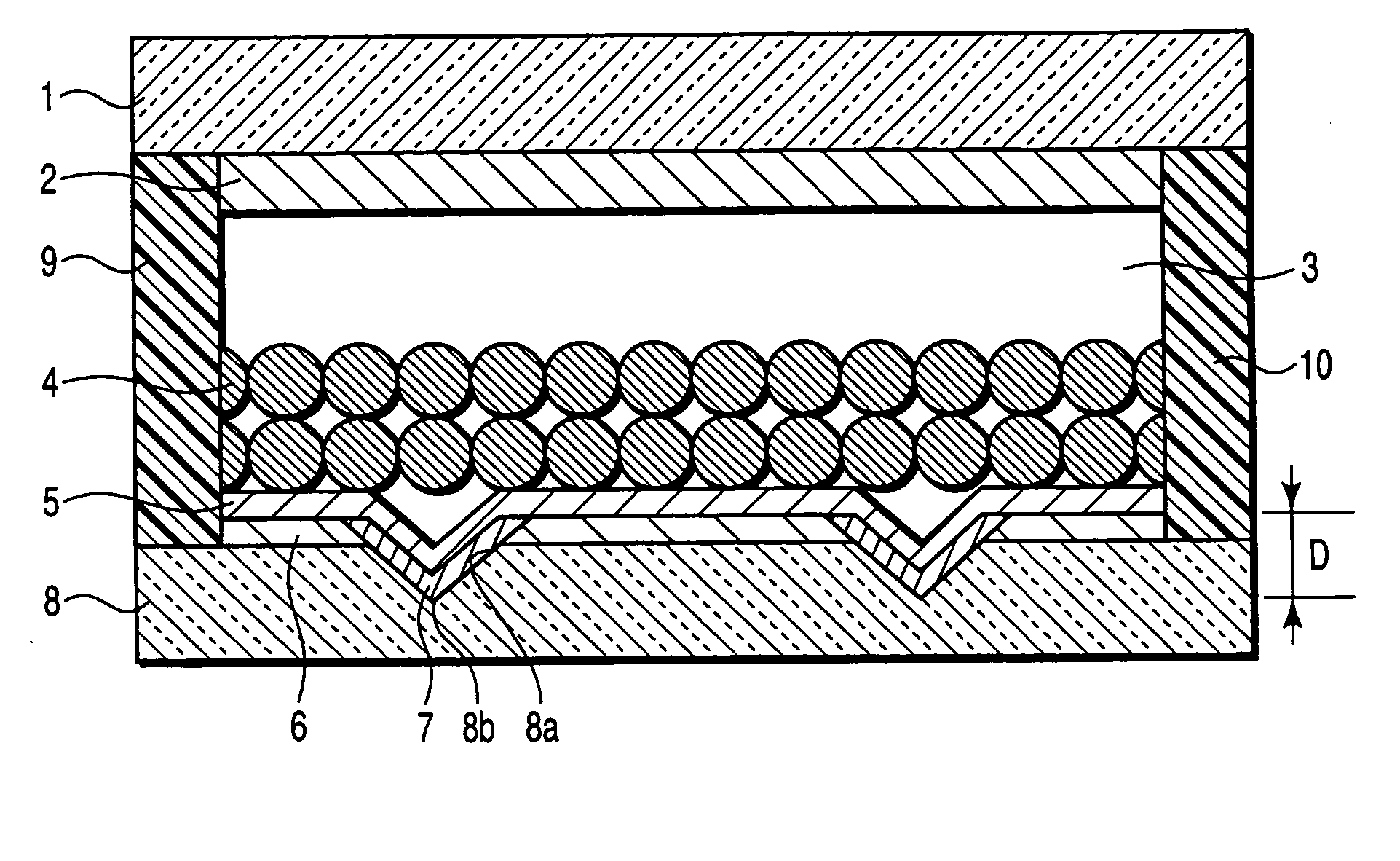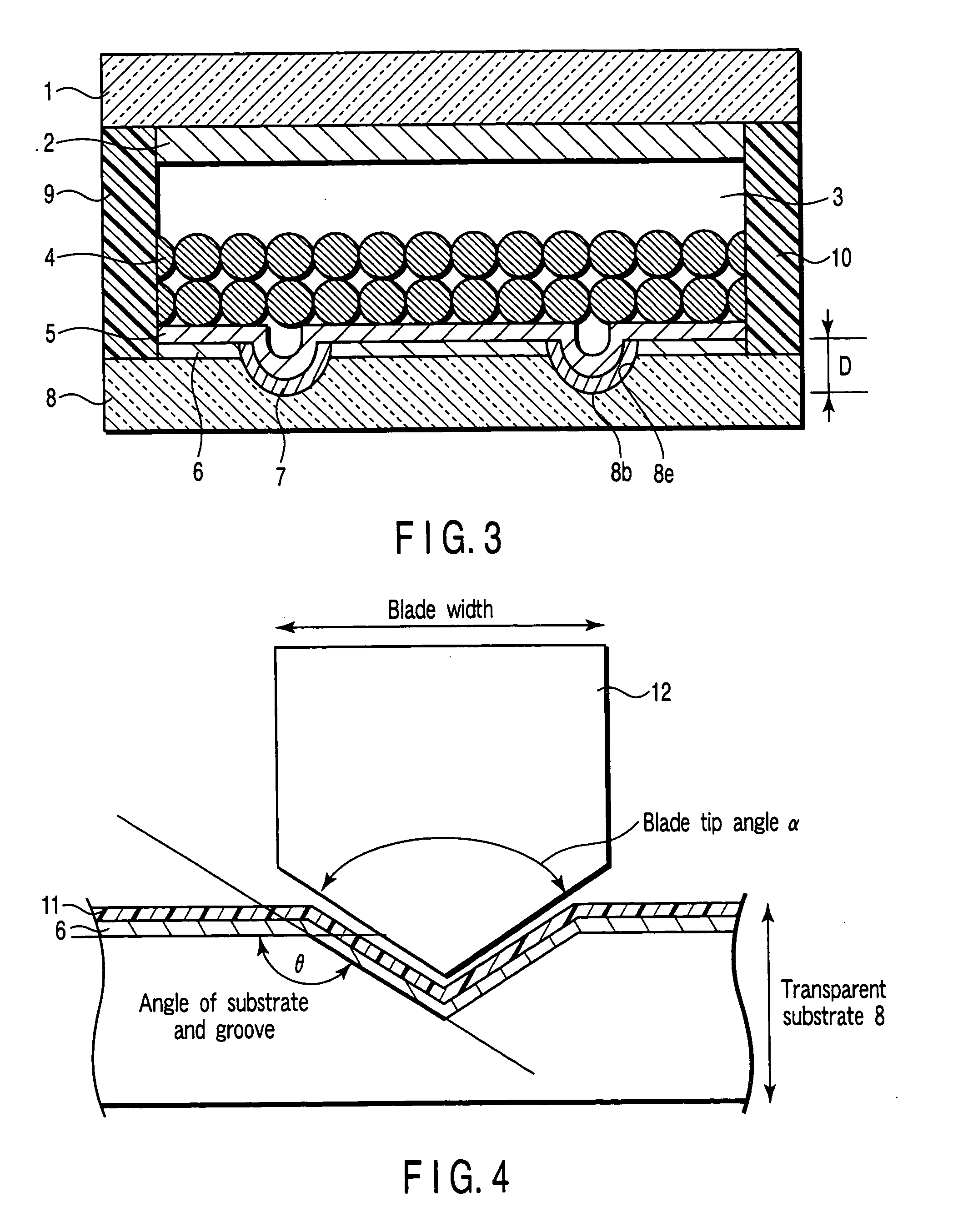Photosensitized solar cell and method of manufacturing the same
a solar cell and photosensitization technology, applied in the field of photosensitized solar cells, can solve the problems of lowering efficiency and inability to ignore resistance, and achieve the effect of high energy conversion efficiency
- Summary
- Abstract
- Description
- Claims
- Application Information
AI Technical Summary
Benefits of technology
Problems solved by technology
Method used
Image
Examples
example 1
[0087] As shown in FIG. 1, on a transparent substrate 8 made of polyethylene terephthalate (PET) resin of 20 cm×15 cm size in a thickness of 100 μm, a transparent conductive oxide film (ITO) made of 90% of tin oxide and 10% of indium oxide was formed as a transparent electrode layer 6 by sputtering in a thickness of 50 nm. On the transparent electrode layer 6, a resist obtained by dissolving polyvinyl benzene in a solvent of xylene at 20% was formed by spin coating, and dried at 100° C.
[0088] As shown in FIG. 4, mounting on a dicing saw with the side on which the transparent electrode layer 6 and resist 11 are formed upside, grooves were processed on the upper surface of the transparent substrate 8 by using a diamond blade 12 of 100 μm in thickness, having a V-form leading end whose angle α is 90 degrees. As shown in FIG. 5, the grooves 13 were formed parallel the lateral direction (shorter side direction) of the transparent substrate 6 at pitch interval L of 10 mm. Grooves interse...
example 2
[0097] A photosensitized solar cell was manufactured by using the same materials and methods as in Example 1, except that grooves were processed in a transparent substrate 8 by using a diamond blade of 50 μm in thickness with leading end shape in stairs as shown in FIG. 2. The angle formed by the upper surface of the transparent substrate 8 and the stair section of the groove was about 135 degrees.
[0098] Similarly, when the energy conversion efficiency was measured, 3.3% was obtained. The microscopic observation of the groove disclosed peeling of the semiconductor electrode 4 of only less than 0.5% of the groove inner surface area, and the stair processing of the groove has proved improvement of peeling strength of the transparent substrate 8 and the current collector wiring 7.
example 3
[0099] A photosensitized solar cell was manufactured by using the same materials and methods as in Example 1, except that grooves were processed in a transparent substrate 8 by using a diamond blade that has a thickness of 100 μm and a U-form leading end as shown in FIG. 3. The maximum depth of the groove was 15 μm. The angle formed by the upper surface of the transparent substrate 8 and the tangent of the groove section was about 150 to 160 degrees.
[0100] Similarly, when the energy conversion efficiency was measured, 3.6% was obtained. The microscopic observation of the groove disclosed peeling of the semiconductor electrode 4 of only less than 1% of the groove inner surface area. The transparent substrate 8 was less in deflection, and the mechanical strength of the solar cell was increased by reducing the depth of the groove.
PUM
 Login to View More
Login to View More Abstract
Description
Claims
Application Information
 Login to View More
Login to View More - R&D
- Intellectual Property
- Life Sciences
- Materials
- Tech Scout
- Unparalleled Data Quality
- Higher Quality Content
- 60% Fewer Hallucinations
Browse by: Latest US Patents, China's latest patents, Technical Efficacy Thesaurus, Application Domain, Technology Topic, Popular Technical Reports.
© 2025 PatSnap. All rights reserved.Legal|Privacy policy|Modern Slavery Act Transparency Statement|Sitemap|About US| Contact US: help@patsnap.com



